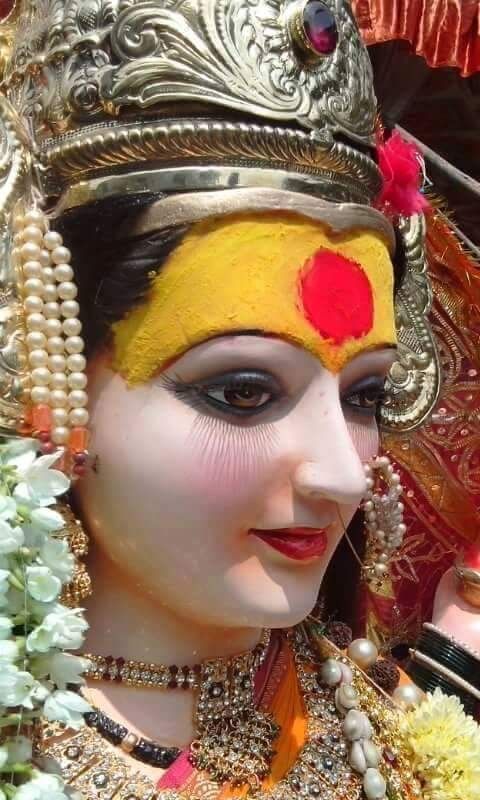No products in the cart.
Devi is a Sanskrit word meaning ‘goddess’; male status is deva. Devi and deva mean ‘heaven, God, whatever is good’, and they are the personal names of the goddess in Hinduism.
The idea and reverence for the goddess comes from the Vedas, dated to about 3rd century BC. However, they did not play a significant role in that period. Goddesses like Lakshmi, Parvati, Durga, Saraswati, Sita, Radha and Kali have continued to be revered in modern times. The medieval period Puranas attests to the proliferation of Devi mythology and literature, with texts such as Devi Mahatmya, in which he portrays it as the ultimate truth and supernatural power. He has inspired the tradition of Shaktism of Hinduism. In addition, Devi and his main form Parvati are considered to be central to Hindu traditions of Shaktism and Shaivism.
Devi and deva are Sanskrit words found in Vedic texts around the 3rd century BC. Deva is male, and related to female equality is devi. Monier-Williams translates it as ‘celestial, divine, supernatural, supernatural, light’. Etymologically, the cognates of devi are Latin dea and Greek thea. When capitalized, Devi maata refers to the mother goddess in Hinduism. Deva is short for devata and devi for devika.
According to Douglas Harper, the root of the etymological dev- means “shiny”, from * div-, “shiny”, is a combination of the Greek words dios, Gothic divine and Latin deus (Old Latin deivos).
The Vedas referred to many deities of the universe, such as Devi (power), Prithvi (earth), Aditi (universal moral order), Vāc (sound), Nirṛti (destruction), Ratri (night), and Aranyani (forest); goddesses such as Dinsana, Raka, Puramdhi, Parendi, Bharati and Mahi are among those mentioned in the Rigveda.
So here are the famous Devi temples:
1. Becharaji

Becharaji or Bahucharaji is a Hindu temple city and the capital of taluka in the Mesana region of Gujarat province, India. The temple of the Hindu goddess Bahuchara Mata in the city is a large center for pilgrims.
The city’s name is derived from Bahuchar Mata or Bahucharaji, the Hindu goddess. The district around the city is known as Chunwal. Bechar village is located 1 km south of the temple and Sankhalpur village is located 2 km north of the temple. A modern village was developed around the temple between the two cities.
Governor Kayajirao Gaekwad had extended Gaekwar’s Baroda State Railway (GBSR) to the city for development.
According to Tantra Chudamani, the left hand of the Goddess fell to Boruvan while Shiva performed the Tandava dance. The temple was built on site. According to legend, the goddess was seen helping the saints who were tormented by Bhundasur or the demon of Dandhasur.
Alexander Kinloch Forbes gave an account of the origin of the temple in Ras Mala: Traditionally, some Charan women were traveling from Sankhalpur to a neighboring village when the Koli invaded and looted. One of the women named Bahuchara snatched the sword from the boy who was listening to her and cut off both of her breasts. He died along with his sister But Bulal also committed suicide. They were reborn as a goddess. Bahuchara is therefore worshiped in Chunwal.
Another legend says that the shepherd boys cooked rice in a small pot of pottery that would never be destroyed and fed the entire army of the skeptical king with the grace of a goddess.
According to Shri Balatripura Sundari Bahucharamba, a Gujarati book published by thetem trust in 1968, tells the story of Solanki princess Tejpal becoming a prince. The story is told in one of Garba’s songs.
The Kamamalia, the Solanki Rajputs of Kalri and the Pavaiyas (eunuchs) claim to be geneticists for the gods. Eunuchs are highly esteemed in the region and one lakh of them gather during exhibitions. When a eunuch was born in a family, his parents left him in the temple where the eunuchs took him and anointed him as a eunuch after 45 days of surgery and closure.
On an average, about 20,000 devotees visit the temple daily. It was visited by about 2,00,000 dedicated people on full moon days and nearly 20 lakhs (two million) dedicated during special shows. The devotees gave gifts of gold and silver jewelry, clothes and money to the goddess. Many held their children’s tonsorial event at Mansarovar Lake near the temple. A grand exhibition is held on the day of the full moon of the Chaitra month of the Hindu calendar. Desiring parents and parents of newborns with physical disabilities or their health offer various offerings to the goddess.
2. Bhandari Devi temple

Bandari Devi Temple is an ancient Hindu temple located about 4 miles [4 km] north of Ahraura, about 25 miles [44 km] away. from Varanasi, 63 km from Mirzapur in Chandauli District of U.P., India. The temple was maintained by the then landlord Shri Shrinivas Pandey and is now in the care of their ancestors. Next to this temple is a stone statue of King Ashoka kept by the Archaeological Survey of India.
It is believed that King Karnpal Singh’s sister (later known as Bandari Devi), after the death of his brother, began living here. He started a kitchen to help the poor (Bhandara) for the needy, hence the name Bhandari Devi. The current site was the site of a demon named Bandodari and his family, who were later killed by Bandar Devi. Currently Bhandari Devi, through rituals, visits ‘Shiv Pahar’, whose parents are at home every third year on a palanquin procession. Anyone can make a wish by donating one or five stones in the temple and when they are given the desire to have the stones removed. Ashoka period inscriptions have been found in the temple precincts. King Ashoka, while on his victory machine must rest for the night here. He loved the peace and tranquility of the place. His ideas about the site are inscribed on stone in the Pali language, and among the inscriptions are figures of birds and horses.
3. Chandi Devi Temple, Haridwar

Chandi Devi Temple, Haridwar is a Hindu temple dedicated to the goddess Chandi Devi in the holy city of Haridwar in the Indian state of Uttarakhand. The temple is located in the remote Neel Parvat on the eastern slope of Sivalik Hills, a mountain range in the southern Himalayas. Chandi Devi Temple was built in 1929 by Suchat Singh during his reign as King of Kashmir. However, the main murti of Chandi Devi in the temple is said to have been erected in the eighth century by Adi Shankaracharya, one of the chief priests of the Hindu religion. The temple also known as the Neel Parvat Teerth is one of the Panch Tirths (Five Pilgrimages) found within Haridwar.
The Chandi Devi Temple is highly revered by devotees such as Siddh Peetha which is a place of worship where wishes are fulfilled. It is one of three such Peeteers found in Haridwar, the other two in the Mansa Devi Temple and the Maya Devi Temple.
The goddess Chandi, also known as Chandika, is the god of the temple. The story of Chandika’s origins is as follows: Long ago, demonic kings Shumbha and Nishumbha conquered the kingdom of the king-goddess of heaven – Indra and threw the gods of Swarga (heaven). After a fervent prayer to the gods, a goddess appeared at Parvati. A very handsome young woman and amazed at her beauty, Shumbha wished to marry her. When he was rejected, Shumbha sent his demon princes Chanda and Munda to kill him. They were killed by the goddess Chamunda who left Chandika in anger. Shamba and Nishumbha still tried to kill Chandika but were killed by the goddess. After that, Chandika is said to have rested for a while on the Neel Parvat summit and later a temple was built here to testify to the legend. Also, the two peaks found in the mountain range are called the Lion and the Lion.
The Temple is located at a distance of 4 km (2.5 mi) from Har ki Pauri. To get to the temple one has to follow a three-mile walk from Chandighat and reach the sanctuary by climbing a few stairs or taking a newly introduced cable car (cable car). A cable service known as Chandi Devi Udankhatola was introduced for the benefit of travelers and caters for pilgrims near Mansa Devi.
The temple is one of the oldest temples in India. Thousands of pilgrims flock to the temple, especially during the festivities of Chandi Chaudas and Navratra and the Kumbela Mela in Haridwar, to seek the blessings of the goddesses who are believed to be fulfilling their wishes. The temple is to be visited by travelers to Haridwar.
4. Chausath Yogini Temple, Khajuraho
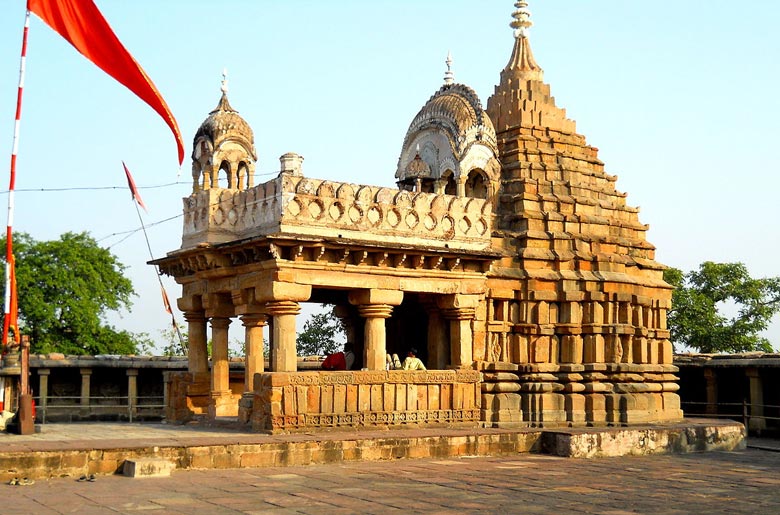
The Chausath Yogini Temple is a Yogini temple destroyed in the town of Khajuraho in Madhya Pradesh, India. Built in the late ninth century, it is the oldest temple in Khajuraho. Unlike the Yogini temples in some places, it has a rectangular structure, but like the hypaethral, it is open to the air.
Construction of the Khajuraho Yogini temple can be traced back to about 885 CE It is the first existing temple in Chandela’s capital, Khajuraho. The temple has been designated as a monument to National significance by the Archaeological Survey of India.
The ruins of the Yogini temples have been found in and around the Chandela-dynasty or in the surrounding areas, including Badoh, Bhedaghat Dudahi, Lokhari, Hinglajgarh, Mitaoli, Nareshwar, and Rikhiyan. This suggests that the Yogini religion was well established in the Chandela area. The temples of Chausath Yogini are connected to the cults of Kapalika and Kaula.
The temple is in the middle of a group of Western temples at an altitude of 5.4 meters. It has a rectangular plan measuring 31.4 m x 18.3 m. It is one of the historic Yogian temples throughout India; most of the others have a circular plan, although those in Rikhiyan and Badoh are also rectangular, so there was at least a local custom of building them in this way. Like all Yogini temples, the Khajuraho temple is hypaethral, open-air.
5. Garjiya Devi Temple
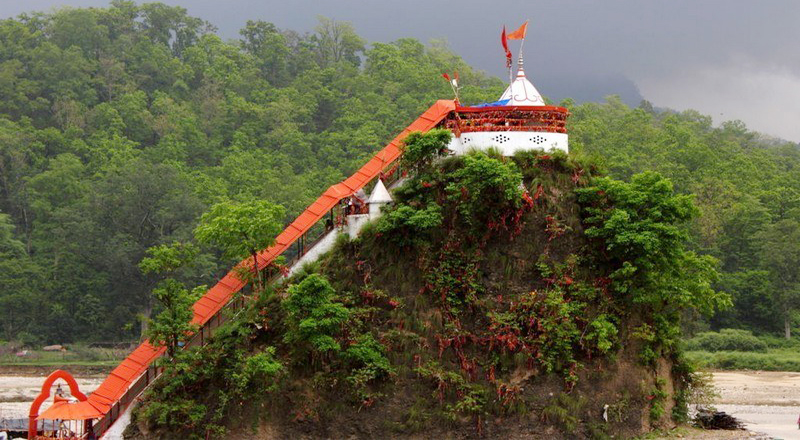
Garjiya Devi Temple is a famous Devi temple located in Garjiya village near Ramnagar, Uttarakhand, India, on the edge of Corbett National Park. It is a shrine in Shakti where Garjiya Devi is the supreme deity. The temple is located on a large rock on the Kosi River and is one of the most famous temples in the region of Nainital, visited by thousands of devotees during Kartik Poornima, a Hindu holy day celebrated on the fifteenth day of the month of Kartik (November – December.) The first priest was Pt. Keshav Dutt Pandey who began worshiping Devi Girija. There is also a 9th-century LakshmiNarayan statue, made of black cowardice. Many people go there every day to worship at the temple. Many people bathed in the river Kosi near the temple in Galilee.
The temple is also known as the festival of the lamps of the gods. The Kartik Purnima festival also coincides with the Sikh festival of Guru Nanak Jayanti.
6. Ithiyapuram kaavu

Sree Vana Sastha Sree Vana Durga Temple, Ithiyapuram Kaavu, Swamiar madam. This ancient temple is located on the National Highway NH-47 from Kanyakumari to Thiruvananthapuram. It is located about 30 km from Nagercoil and about 52 km from Thiruvananthapuram and is located on the Swamiyarmadam-Verkilambi road, near the Kovikal Bridge.
Its exact age is unknown. However, its age should be greater than eon.
In this temple the chief deity is Sree Vana Sastha and the chief goddess is Sree Vana Durga. The gods Bala Ganapati, Nagaraja, Naga Yakshi, Naga Kanni, Sree Krishna, Sree Eeshvarakala Boatoraan are also found. In this shrine Sree Vana Sastha, Sree Vana Durga and Bala Ganapathy the gods manifest themselves. There, in this shrine, the goddess Sree Vana Durga is in the realm of Repentance, and the god Sree Bala Ganapathy discovers her true nature day by day.
There are gold snakes, white snakes and King Cobras in the forest behind the temple that many saw long ago. The huge trees surrounding the temple are an important eon symbol of this temple. And no one is allowed to enter the forest area behind the temple.
Long ago, the King of Travancore Marthanda Varma ran through this area to save his life and after that the Lord gave a bronze record of legal documents as a gift to this temple and it was said by the people of his time. No one was going to care for the temple for long and it was destroyed. In the past this temple was well maintained because of the action taken by the local community and the normal operation that took place. The Panhuni Uthram five-day festival is celebrated in this temple. In the month of Karthigai Mandala Pooja for 41 days, Powrnami Pooja, Aayilya Pooja also takes place. Every evening Santhya Pooja happens as Nithya Pooja.
It is believed that the goddess Sree Vana Durga came all the way from the dense forest of Pechiparai and protected her God Sree Vana Sastha and an army of snakes from there in the area. In all the days of powrnami one can have Nager dharshan without fail.
7. Maa Markama Temple

The Maa Markama Temple located in the Bissam Cuttack area of Rayagada district is a tourist attraction. It is the only shrine (Shakti Peethas) of Devi Maa Markama and Maa karkama in the Indian state of Odisha. The Maa Karkama Temple (believed to be Maa Markama’s sister) is located near the Maa Markama temple. Legend has it that Devi has been worshiped for centuries. However, the temple was rebuilt in the past. The small college and university college at Bissam Cuttack are named after Maa Markama. The temple is one of the main tourist attractions in the Rayagada region. Dussehra and chaitra Paraba are celebrated annually at the temple. The nearest train station is Chatikona, 7 km (4.34 miles) from Bissam Cuttack.
According to historical references, Kalahambir, king of the kingdom of SURYA (Suryavansi), ruled the Bissam cuttack and Devi Maa Markama was the Ishtadevi of the royal family. [7] The practice of human sacrifice was widespread and stopped during the British occupation. However the tradition of donating buffalo continued, which was instituted by the then District Commissioner Shri Gadhadhar Mishro (01.07.1953-19.03.1955). References to Devi Maa Markama can also be found on CHANDI PURANA of Sarala Dash and on BATA ABAKASH of Matta Balarama Dash. Devi is called Utkaleeya (Oriya of the word “of Odisha”) jogging in fairy tales. A few legends say that Devi Markama helped the King of Bissam Cuttack during the war by entertaining enemy soldiers.
8. Mata Mansa Devi Mandir
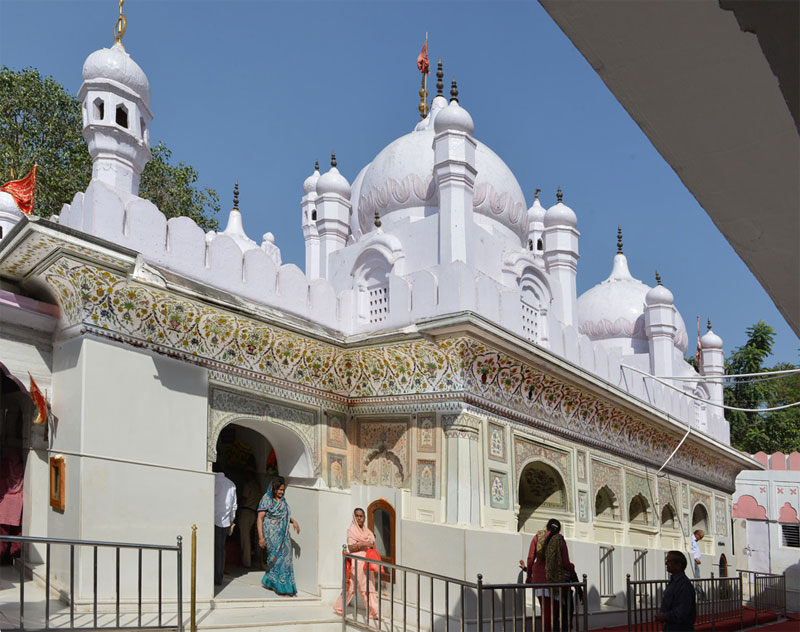
Mata Mansa Devi is a Hindu temple dedicated to the goddess Mansa Devi, a form of Shakti, in the Panchkula region of the Indian state of Haryana. The temple complex is still spread over 100 hectares (0.40 km2) of the Shivalik Mountains in the village of Bilaspur, near Sector 13 (formerly known as Mani Majra) of Chandigarh, and Panchkula, 10 km from Chandi Mandir, another respected Devi area in the area. region, both just outside Chandigarh.
It is one of the Shakti Pitha temples of North India featuring the seven Shakti goddesses, namely Mata Mansa Devi, Naina Devi, Jawalamukhi, Chintpurni, Brajeshwari, Chamunda Devi and Jayanti Devi. Thousands of devotees visit the sanctuary from various parts of the country, and especially during the Navratra mela, this number rises to lakhs daily for nine beautiful days.
There are 3 temples in the complex and the largest temple is the oldest. Maharaja Gopal Das Singh of Mani Majra, who was enthroned in 1783, built the present-day Shri Mansa Devi Temple, located on the Shivalik mountain in the Bilaspur, Tehsil and District Panchkula districts, during 1811-1815. At a distance of 200 meters from the largest temple is the temple of Patiala Shivalaya built by Karam Singh, Jat Sikh, who was the Maharaja of Patiala in 1840. This temple was sponsored by Manimajra Princely State.
There are 3 temples in the complex, the largest Shri Mansa Devi temple built in 1811-1815 by Maharaja Gopal Das Singh of Mani Majra the oldest, the Patiala Shivalaya temple built in 1840 by Patiala Maharaja Karam Singh is 200 meters from the Mountain. the great temple of Shri Mansa Devi. Haryana Samvad Archived 29 November 2018 at Wayback Machine, Oct 2018, p39. In the Shiva temple, there are 38 panels of paintings and floral designs painted on the roof and arches leading to the temple, which according to the inscription painted by Aged at Vikram Samvat 1870 (813 CE).
9. Naina Devi

Shri Naina Devi Ji is one of the most famous places of worship in Himachal Pradesh. Located at Ditt Bilaspur, it is one of 51 Shaktipeeths where Sati members fell to the ground. This shrine testifies to a large number of pilgrims and devotees throughout the year and especially during the Shravan Ashtami and Navratras of Chaitra & Ashwin.
A special exhibition is organized during the Chaitra, Shravan and Ashwin Navrati, which attract millions of visitors from Punjab, Haryana, Delhi, Uttar Pradesh and other parts of the country.
The temple of Shri Naina Devi Ji is located on a hill, the base of which is the shrine of bhagat Jeona Morh who died in the 12th century, in the region of Bilaspur, Himachal Pradesh, India. The temple is connected to National Highway No. 21. The temple on the hill can be reached by road (which is winding around the hill to reach a certain point) and then solid steps (which will eventually reach the top). There is also a cable car that transports passengers from the bottom of the hill to the top.
Naina Devi hills overlooking the Gobind Sagar lake. The lake was built by Bakra-Nangal Dam.
Several issues are related to the founding of the temple.
According to legends also written in the Veds and Purans, Goddess Sati burned herself alive in Yagna, which oppressed King Shiva. He took Sati’s body by the shoulder and began his Tandava dance. This terrifies all the gods in heaven as this could lead to the annihilation of the nation. This prompted King Vishnu to release his Chakra which cut Sati’s body into 51 pieces. The Shri Naina Devi Temple is the place where the eyes of Goddess Sati fall.
The Shri Naina Devi Temple is also known as the Mahishapeeth due to the demonic defeat of Mahishasur by the goddess. According to legend, Mahishasur was a powerful demon who was blessed with immortality by King Brahma, but the condition was that he could only be conquered by an unmarried woman. Thanks to this blessing, Mahishasur began to spread fear in the Earth and in God. In order to deal with the demon, all the gods combined their power and made Devi defeat him. Devi was given different types of weapons by all the gods. When Mahishasur was amazed at Devi’s amazing beauty and proposed to her. Devi told her that she would marry him if he could defeat her. During the battle, Devi defeated the demon and cast out both of his eyes. This prompted God to applaud “Jai Naina” and that is why the name.
10. Parhul Devi Temple
Parhul Devi Temple is the temple of the goddess Durga in the village of Lamahra in the Kanpur Dehat region, Uttar Pradesh, India.
The temple is located in the village of Lamahra on the right bank of the Rind River 3 km (1.9 mi) from the Rura-Shivli road. The nearest railway station is Rura North Central Railway. The distance between Parhul Devi Temple and Rura Railway Station is about 9 km (5.6 mi). Bus and taxi are available from Rura to Parhul Devi Temple.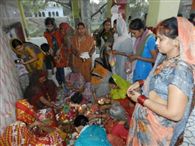
The goddess Parhul and Lord Mahadev were found in a temple by King Singha of the Parhu region in the 12th century. Parhul Devi is mentioned in Parmal Raso (Aalh Khand). Hero Alhaa built a golden light for Kund on the temple campus to fulfill his desire to win the battle. The glow of this golden Jyoti Kund reached the palace of Kannauj. The Queen of Kannauj (Padma) was disturbed while she was asleep because of the golden Kund light of the Parhul temple. Thus, the warrior Udal threw it into the Rind River.
The exhibition is held here during the Basanti Navratri in the month of Chaitra and during the Shardiya Navratri in the month of Ashwin in the Hindu calendar each year. The show starts on the first day of Navratri, which means it runs from Pratipada to Durga Ashtami.
11. Patnadevi
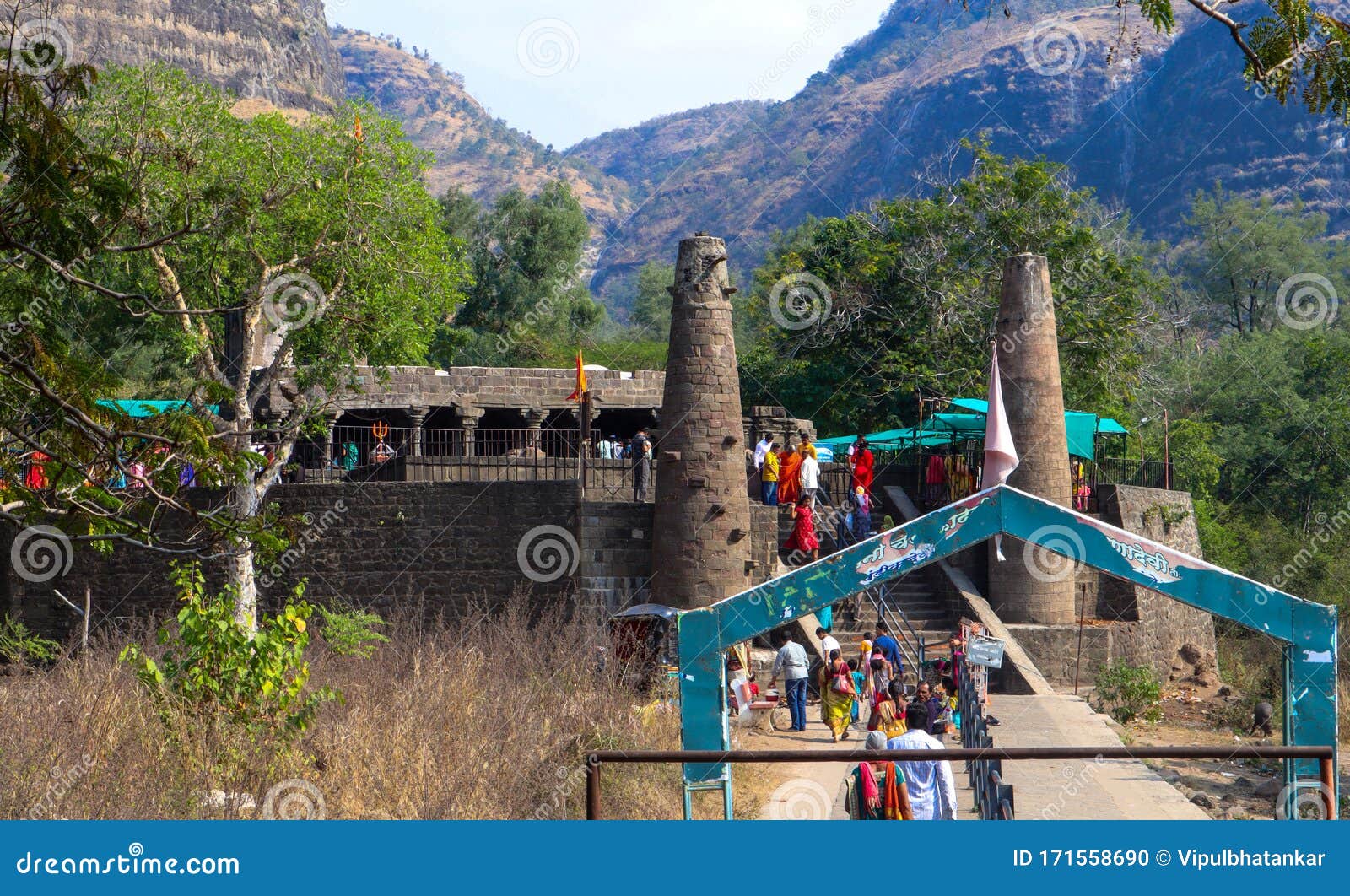
Pananadevi is a historic tourist site located 18 miles [18 km] southwest from Chalisgaon, Maharashtra. The site is within the Gautala Autramghat Sanctuary and is surrounded by the high mountains of Sahyadri.
It contains the Chandika Devi Temple and the Hemadpanthi Mahadev Temple.
In earlier days, this was the capital of an important Province called Patna (Vijjalgad) consitance. It was ruled by a former king in the Yadav dynasty and their tributary. The capital was 4–5 miles long and wide at the time. The city was surrounded by a towering mass, and its beauty was enhanced by the surrounding forest. In the surrounding forest there were varieties of fruit trees, and outside the main road. Water was supplied to the city by digging water tanks on a high mountain. The city has been famous for trade, art, reading, crowds and temples since the time of Shalivahan Saka due to its iron ore mines and various hill plants. At that time, the Mandlik dynasty of Yadav built the Siddheshwar Temple in Waghli (991), the Shardadevi Temple in Bahal (1144), and the Chandika Devi Temple in Patna (1128).
Bhaskaracharya or Bhaskara II was a 12th-century Indian mathematician. He was also a well-known astronomer at the time. He lived in Aashram in Patnadevi. He is said to have written his famous magnum opus, Siddhanta Shiromani in Patnadevi.
12. Belha Devi Temple
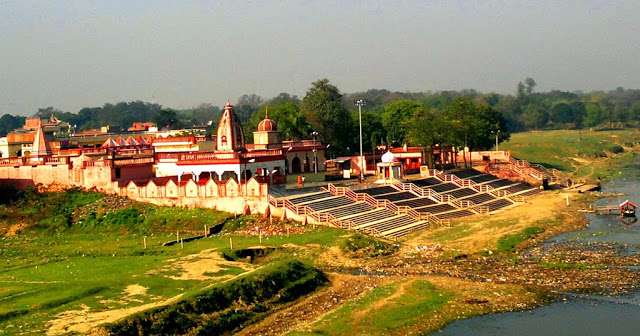
The Belha Devi Temple is an ancient Hindu temple in the city of Bela Pratapgarh, dedicated to the goddess Belha, the local birth of Devi (Mother Goddess).
The Belha Devi Temple is one of the Shakti temples located in the Pratapgarh region of Uttar Pradesh, India. The name of the city Bela (now called Bela Pratapgarh or Pratapgarh) is derived from Maa Belha Devi. The temple was dedicated to the city’s goddess Belha Bhavani.
The Mata Belha Devi Temple in Pratapgarh is a symbol of Hindu culture and faith. The temple on the Sai River is an example of the ancient Shakti worship of northern India. Belha Devi is the site of Shiva and his wife ‘shakti’ became the center of shakti worship.
However, the present temple which is a testament to the happy past of the Pratapgarh region is about two hundred years old. The archaeological finds in the uttar pradesh region provide a vivid glimpse into the history and culture of the area from ancient history to recent times. Although due to the onslaught of time and circumstances many of the practical realities of cultural manifestations in the lost realm, there are still some things that will never end. One such example is the Belha Devi Shrine and the shaktism tradition practiced in this part of the country, where the past has been revived to support the living tradition of shaktism in India.
Raja Pratap Bhahadur Singh of Awadh built the present-day Shri Belha Devi Temple, located on the banks of the Sai River in Pratapgarh Oblast, during 1811-15.
The temple was sponsored by Awadh State. The Raja of Pratapgarh designated the pujari as the “Pujari Name” of this temple whose function was to worship the god of the temple. Following the unification of the imperial and provincial states these pajuras became independent in matters of control and administration of the affairs of the temple and the land connected with the temple. They take care of the temple and provide needed services to the pilgrims and thus the temple’s condition continues day by day. So much so that there were proper arrangements for pilgrims visiting the temple during the Navaratra melas.
In the sanctum area Belha Devi is worshiped in the form of pindi (stone stones). Initially, pints were served only by devotees. However, in modern times the marble bust of the deity was carved to give an attractive human appearance (form) to the deity. The goddess is adorned with a crown and other ornaments.
13. Prathyangira Devi Temple, Shollinganallur
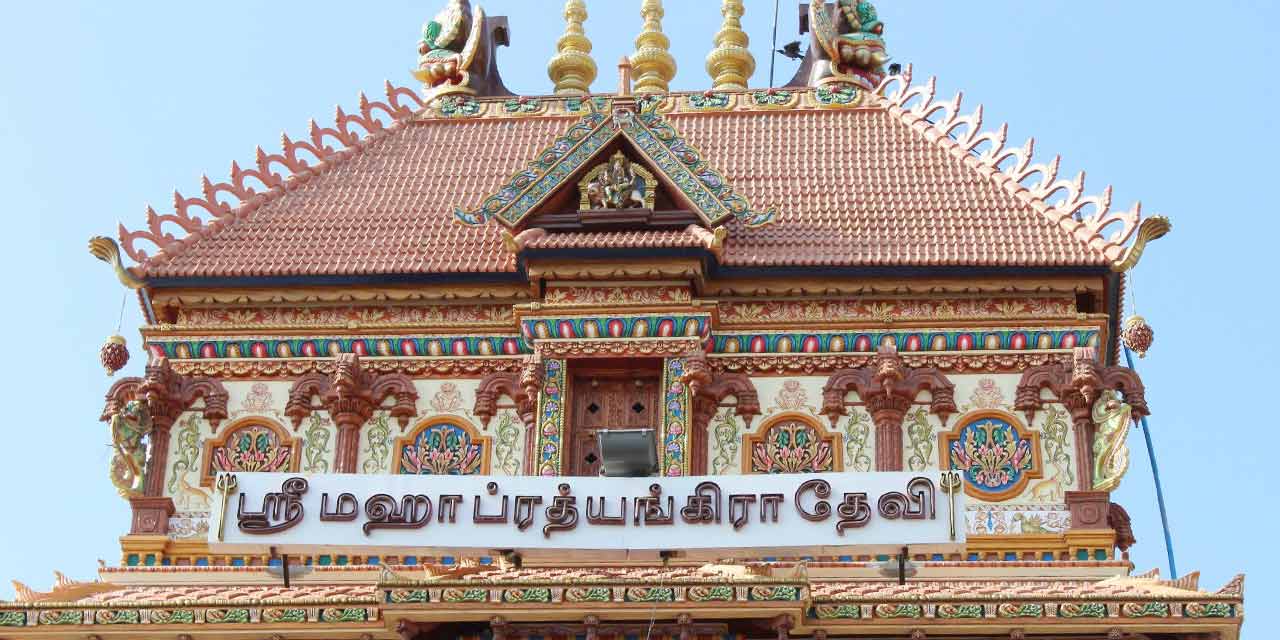
The Sri Maha Prathyangira Devi Temple is located in Sholinganallur, Chennai, India, near the shores of the Bay of Bengal. The temple sits on the shores of the Buckingham Canal. This is a beautiful temple built for the goddess Prathyangira, in her body Shri Maha Prathyangira Devi. He is considered to have the power to ward off evil influences, and he is said to have the power to punish Adharma. This is one of the few temples of Prathyangira and one of the temples of Shri Maha Prathyangira Devi, a Shanta form.
Other revered gods at this famous temple are Goddess Varahi, Goddess Neela Saraswathi, Lord Sarabheswara, Lord Ganesha, Lord Muruga, Lord Panjamukha Anjaneya, Lord Agni, Goddess Kaalikaambal, Lord Ayyapa, Lord Saniswara, Lord Narasimha, Lord Rahu and Ketu. , King (Guruvayoorappan) and King Shiva.
Homas are performed in the temple only on special occasions and are free and anyone can participate, no agent or pre-booking of a homam in this temple within India or any other country but there are scammers pretending to be a homam agent but not related to this temple, homam designed for public welfare and free for all.
14. Shri Kali Devi Temple, Patiala

Shri Kali Mata Temple overlooks the Baradari garden on Mall Road of Patiala City (Punjab). The Temple was built by the Governor of the Sikh Province of Patiala Maharaja Bhupinder Singh, who funded a building in his capital, Mata Kali Devi Temple, and presided over its installation, in 1936. Bhupinder Singh was the ruling Maharaja of the princely district of Patiala since. 1900 to 1938. He was inspired to build the temple and to bring the 6-ft statue of Divine Mother Kali & Paawan Jyoti from Bengal to Patiala and to offer the “First Bali” (sacrifice) of the water buffalo at the Kali temple in Patiala. . Thanks to the excellent infrastructure of the Temple, it has been declared a national monument. This huge structure attracts devotees, Hindus and Sikhs, who come from far and wide. The oldest temple of Raj Rajeshwari is also located in the center of the building. The devotees donated Mustard oil, daal (lentils), sweets, coconut, bangles and chunnis, goats, hens and alcohol to the Divine Mother here.
Shri Kali Devi Temple was built by Maharaja Bhupinder Singh of Patiala in 1936. The Maharaja was inspired to build a temple and brought the six-foot-tall statues of Maa Kali and Paawan Jyot from Bengal to Patiala. This huge structure attracts devotees from far and wide. The oldest Shri Raj Rajeshwari ji temple is also in the center of the building. Thanks to the excellent infrastructure of the Temple, it has been declared a national monument. The devotees donated Mustard Oil, daal (lentils), sweets, coconut, bangles, chunnis, goats, chickens and alcohol to the Divine Mother here.
15. Temblai

Temblai Devi or Tryamboli (as locally known) is a form of Renuka devi, the body of the goddess Durga and the supreme deity of the temple on a hill in the eastern part of Kolhapur, Maharashtra, India.
Because of its temple, the hillock temple on it is known as Mount Temblai. The temple building consists of two temples, the main temple to the south is Temblai devi and the smaller northeast is dedicated to Yamai devi. The area is surrounded on the north side of the road and on the south side are military bases. Devotees, especially women who visit the temple and pray to marry a man of their own choosing or if they are married, wish and pray for the longevity and health of their husbands. It is also a well-known destination for tourists and locals. The Temblai Temple building is known as one of the many tourist attractions in the city. There is another Temblai devi temple near the Panchganga River in Kadamwadi not far from this magnificent temple.
The temple complex has a large statue of Ganpati on the open plains on the northeast side of the temple. Next to the statue of Ganpati is a small statue of the Chhatrapati Shivaji monument erected by the Devasthan committee. Local authorities have upgraded the area with a small children’s park. In pre-independence times, hillock was a center for the treatment of patients with tuberculosis due to the cool breeze blowing over the hill.
One of the lesser-known temples of Goddess Temblai is located in the town on the banks of the Panchaganga River in Kadamwadi, on the northeast side of the city.
Local legends say that the goddess Renuka is the sister of Mahalaxmi and actively supported Mahalaxmi in her efforts to destroy the demons in the region. However, after the war, Mahalalelmi did not pay homage to the goddess Renuka and descended the hill, where she turned her back on Mahalalel. This is one reason why the statue of Mahalalel in his temple is facing west and that of the goddess Renuka in Temblai is facing east. Every year during Navratri there is a procession celebrating the reconciliation of the two sisters on the fifth day of Lalitpanchami.
During the month of Shravan, pilgrims flock to the temple during the annual pilgrimage known as the Temblai yatra (jatra) when pilgrims from distant parts of Kolhapur and Belgaum come to worship the goddess. Every year in the middle of Navratri, on the fifth day of Lalitapanchami, a procession of palkhi is taken from the Mahalaxmi temple to the Temblai mandir on the Temblai hill. Since 2013, more than 1 million devotees have visited the temple during the Navratri festival. The vernacular uses a common greeting from the Goddess Tembali chya navane chang bhala, which has been widely used by sholka and devotees who sing and perform during the annual pilgrimage and at other times in their homes. During the festival special arrangements were made by the management to control the traffic and diversions to make it easier for volunteers. The royal family of Shahu II had a special tribute to the Temblai exhibition as people were especially important to his presence during the event.
16. Vadakkan Koyikkal Devi Temple Puthiyavila
 Vadakkan Koyikkal Devi Temple Puthiyavila is located in Puthiyavila, Kayamkulam. The chief deity of the temple is Goddess Parvathy. Other deities worshiped are Lord Shiva, Bhadrakali, Sree Dharma Sastha, Naga Nevada, Khandakarna, Yekshi, Yogishwara and Brahma Rakshas. The most impressive site of the Vadakkan Koyikkal temple are the large two-story temples. Sree Parvathy’s main idol was sitting on the floor while Shiva sat on the first floor.
Vadakkan Koyikkal Devi Temple Puthiyavila is located in Puthiyavila, Kayamkulam. The chief deity of the temple is Goddess Parvathy. Other deities worshiped are Lord Shiva, Bhadrakali, Sree Dharma Sastha, Naga Nevada, Khandakarna, Yekshi, Yogishwara and Brahma Rakshas. The most impressive site of the Vadakkan Koyikkal temple are the large two-story temples. Sree Parvathy’s main idol was sitting on the floor while Shiva sat on the first floor.
Celebrations celebrated in the temple of Vadakkan Koyikkal Devi Puthiyavila Kumbha Bharani and Navaha Yekngam. Kumbha Bharani is a great temple festival. It is celebrated on the Bharan Day of the Malayalam calendar month Kumbham. The devotees believe it is the birthday of Vadakkan Koyikkal Devi. The 10-day festival is celebrated with great ease. Kettukazhcha is celebrated on the 9th and 10th day.
Navaha Yekngam is another 9-day festival celebrated in the Vadakkan Koyikkal Devi Temple. The 9-day festival is celebrated April – May. During these nine days, the religious festivals in the temple continue. Every nine days, Annadana is played.
17. Vaishno Devi Temple
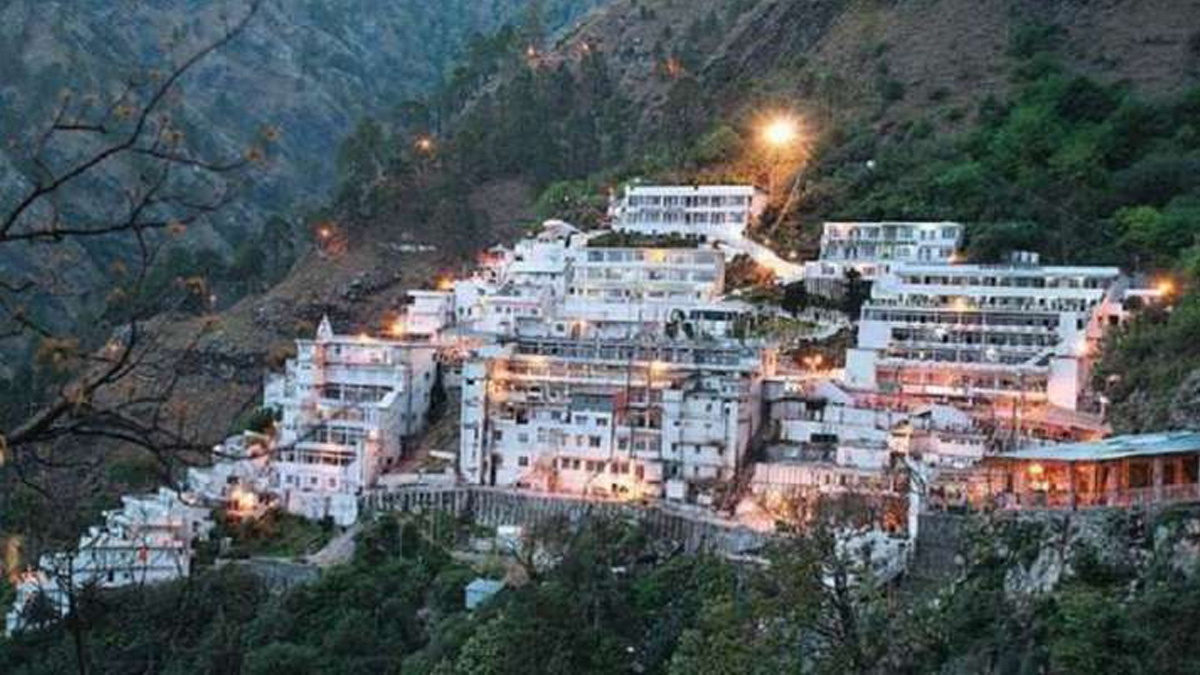
Vaishno Devi (also known as Mata Rani, Trikuta, Ambe and Vaishnavi) is a human manifestation of the Hindu mother goddess, Devi. The words “Maa” and “Mata” are commonly used in India when referring to the mother, and thus are more commonly used in connection with Vaishno Devi. Vaishnavi was formed by the combined forces of Parvati, Lakshmi, and Saraswati. The temple is located in Katra, India.
Author Abha Chauhan identifies Vaishno Devi with the power of Vishnu and the personal status of Lakshmi. Author Pintchman identifies the great goddess Mahadevi and says that Vaishno Devi contains all the power and is associated with all creation as Mahadevi. Pintchman went on to say, “The Pilgrims identified Vaishno Devi and Durga (a type of Lakshmi) – the Punjabis (and others) also called Sheranwali,” the Rider of the Lion “- more than any other goddess”. Some Hindus also view Vaishno Devi as the future happiness of Kalki and he is born as Satyabhama and will be born as Rama the wife of Kalki.
The appearance of Vaishno Devi in Shridhar and the story of Bhaironath
It is said that Bhaironath, a famous Tantric, saw young Vaishno Devi at an agricultural show and went crazy with having an affair with him. Vaishno Devi fled to the hills of Trikuta to escape his romantic intimacy, later taking Mahakali’s position and cutting off his head with his sword in a cave. Professor and author Tracy Pintchman tells the story, “About nine hundred years ago Vaishno Devi appeared in the form of a young girl and ordered a Brahmin named Shridhar of the village of Hansali (next today in Katra) to hold a banner for the local people near the Bhumika River. However, Vaishno Devi told him that he would only get vegetarian food, because this was a Brahmin festival. Seeing him, Baironath. ), Charan Paduka (Holy steps), Ardha Kunwari — a place where he is said to have lived for nine months in a cave, and finally in Bhavan, a cave now known as his home. i), beheaded Baironath, his body was seized. at the entrance of the cave, and his head rested on a mountain in the area where the now-existing Bhaironath temple is. Bhaironath then repented, and the goddess gave him additional salvation. In doing so, however, he stipulated that unless the pilgrims went to worship at his darshana, they would not receive his darshana — that is, the darshana of his head — then their journey would be fruitless. Vaishno Devi later appeared on 3 small rocks (pindikas) and remains there to this day. Shridhar began to make puja in pindika cave, and his descendants continue to do so today “.
18. Chamunda Devi Temple

Shri Chamunda Devi Mandir also known as Chamunda Nandikeshwar Dham is a temple 19 kilometers from the city of Palampur in Dharamshala Tehsil in the Kangra region of the North Indian subcontinent Himachal Pradesh dedicated to Shri Chamunda Devi, a type of Goddess Durga. This is one of the most famous temples in Himachal Pradesh and one of the most famous temples in India. It is believed that any vow made herein reflects the truth. The magnificent Temple of Aadi Himani Chamunda is much older than this, it is steep and difficult to reach, which is why 400 years ago this temple was built to liberate believers.
His temple dates back to the 16th century and contains many spiritual myths connected with it. In fact, there is a legend associated with the demolition of this temple. According to this legend, about 400 years ago, a king and priest prayed to Shri Chamunda Devi for permission to remove the statue from a public place. Legend has it that the goddess appeared to be a priest and told her exactly where the image would be found. This was reported to the king and his men and brought back the ancient image and placed it on the site of the present temple.
It is one of the most famous temples in India. The Chamunda Devi Temple has always been a major tourist attraction for anyone visiting Palampur. The temple attracts pilgrims from all parts of India, not only because of the many spiritual myths associated with it, but also because of its ancient temple and architecture, built on the site of Himachali. The temple also proved to be a popular destination for photographers. Apart from that, the ancient idol of Shri Chamunda Devi, also makes an interesting topic among travelers, photographers and devotees alike. Aside from the many tourists visiting the Chamunda Devi Temple as a major tourist attraction in Palampur, local residents living in the mountainous region consider it one of the most sacred places of worship in the area, largely because of its fascinating myths and history. attached to it. These residents and other devotees from neighboring mountain towns visit the temple to pray to the goddess.
A small temple called Jakhni Mata Mandir perched on a hill overlooking the area and providing a spectacular view of the valley. It is accessible by a short hiking trip.
19. Kamakhya Temple

Kamakhya Temple is a Hindu temple in the Nilachal hills of Guwahati, Assam. Dedicated to the mother goddess Kamakhya, it is one of the oldest and most revered centers of the Tantric tradition. The temple is the center of the Kulachara Tantra Marga and the site of the Ambubachi Mela, an annual festival celebrating the menstrual cycle of the goddess. In terms of architecture, the temple was built in the 8th-9th century and many reconstructions followed – and the final mixed construction defines a local style called Nilachal. It is also one of the oldest pithas in 51 Shakta tradition. An obscure place of worship in much of history became an important place of pilgrimage, especially for those from Bengal, in the 19th century during colonial rule.
Originally a place of worship for the local goddess where the main worship of the aninic sinus set in natural stones continues to this day, the Kamakya Temple was associated with state power when the Mleccha dynasty of Kamarupa first supported it, followed by the Palas. the Koki, and the Ahomites. Kalika Purana, written during the Pala dynasty, linked Naraka, the legitimate ancestor of the Kamarupa dynasty, with the goddess Kamakhya, who represents the region and empire of Kamarupa.
The present-day temple and architectural sculpture on the nearby stone indicate that the temple was built and repaired many times over in the 8th-9th, 11th-12th, 13th-14th centuries and even later. [7] The present form, dating from the 16th century, provided a mixed style sometimes called the Nilachal type: a temple with a hemispherical dome over the cruciform base. The temple has four chambers: the garbhagriha and three mandapa in the area called calanta, pancharatna and natamandira aligned from east to west.
Kalika Purana, an ancient Sanskrit book, describes Kamakhya as the creator of all desires, the youngest Shiva bride, and the provider of salvation. Shakti is known as Kamakhya. Tantra is the center of worship, on the courtyard of this ancient temple of the mother goddess Kamakhya.
The worship of all the goddesses in Assam symbolizes the “integration of beliefs and practices” of the Aryan and non-Aryan elements in Assam. Yogini Tantra refers to the Yogini Pitha religion as the origin of Kirata. According to Banikanta Kakati, there was a tradition among priests that Naranarayana established that the Garos, a relative of the tribe, worshiped in the former Kamakhya area by offering pigs. The ritual of sacrifice continues even today when devotees come each morning with animals and birds to offer to the goddess.
20. Karni Mata Temple

Karni Mata Temple is a Hindu temple dedicated to Karni Mata in Deshnoke, 30 kilometers from Bikaner, Rajasthan, India. Also known as the Mouse Temple.
The temple is famous for the nearly 25,000 black rats and the few (rarely) white rats that live, and are revered, in the temple. These sacred mice are considered Depawat charan in previous births, both of which give birth to the Depawat charan cycle and mice respectively. Many people travel long distances to pay homage. The temple attracts visitors from all over the world for blessings, as well as curious visitors from all over the world.
Legend has it that Lakshman, the son of Karni Mata, drowned in a lake at Kapil Sarovar in Kolayat Tehsil while trying to drink from it. Karni Mata begged Yama, the god of death, to resurrect her. At first refusing, Yama finally agreed, allowing Lakshman and all of Karni Mata’s sons to be reborn as mice.
Eating foods eaten by rats is considered “highly regarded”. Temple rules say that if you accidentally step on a mouse and kill it, you should replace it with a mouse made of silver or solid gold.
The temple is open to the public early in the morning at 04:00. Chanite priests perform Mangla-Aarti and offer bhog (special food) for worship. Volunteers make offerings to rats, roam the temple in droves, and are considered fortunate. Donations include cheese and sweets. There are also milk jars around the temple for the mice to enjoy. There are two types of offerings made: ‘dwar-bhent’ is said to be made by priests and laborers, and ‘kalash-bhent’ is used for the maintenance and improvement of the temple.
Many worshipers believe that rat saliva is healing and that they will share food with milk and rats. The great point about the temple is that it was near before the bubonic plague.
The Karni Mata Fair is held twice a year in Deshnoke:
- The first and largest exhibition is held in March – April during the Navratras from Chaitra Shukla Ekam to Chaitra Shukla Dashmi.
- The second show takes place in September – October, and during Navratras, from Ashvin Shukla to Ashwin Shukla Dashmi.
During the Navratri thousands of people made the trek to the temple on foot.
21. Kanaka Durga

The Kanaka Durga Temple is a Hindu temple dedicated to the goddess Kanaka Durga. The god of this temple is also known as Kanaka Durga. The temple is located in Vijayawada, Andhra Pradesh, India on the Indrakeeladri hill, on the banks of the Krishna River. Kaalika puraana, Durgaa sapthashati and other vedic books mention the goddess Kanaka Durga in Indrakeelaadri and describe the deity as Swayambhu, (self-proclaimed) in Triteeya kalpa.
A popular legend is about the victory over the goddess Kanakadurga, also known as Kanaka Mahalakshmi, over the demon King Mahishasura. It is said that the proliferation of demons became unbearable for the natives. Sage Indrakila made great remorse, and when the goddess appeared Sage begged her to stay on her head and keep an eye on the evil demons. According to her desire to kill the demons, the goddess Durga made Indrakila her permanent abode. Later, he also killed the demon king Mahishasura freeing the people of Vijayawada from evil.
At the Kanakadurga Temple, a magnificent 4-foot (1.2 m) idol is adorned with glittering ornaments and bright flowers. His icon here shows His character armed with eight weapons – each with a powerful weapon – in a position to stand over the demon Mahishashura and pierce him with His three trident. The goddess is a perfect example of beauty.
The Kanaka Durga Temple is similar to Vijayawada. It is mentioned in the scriptures.
It is said in Hindu texts that the deity in the temple of Kanakadurga is considered to be ‘Swayambhu’ or self-proclaimed, which is why he is considered to be the most powerful.
The Kanaka Durga worshiped in the temple is the Mahalakshmi way of Lakshmi Durga. All poojas related to the Lakshmi devi are performed in the temple. In the month of Shraavana, the Varalakshmi Vratam is performed every Friday with special honors. More than 20,000 people attend the celebrations this month. Special pujas were made during the Dasara called Navaratri. The festival of Dasara is celebrated here in this temple every year. The temple-worshiping god Mahalakshmi. A large number of pilgrims go to colorful festivals and immerse themselves in the Krishna River.
Records of various generations are found in the temple.
So these are some of the famous Devi temples with their significance. Each temple has its ow significance and importance.

